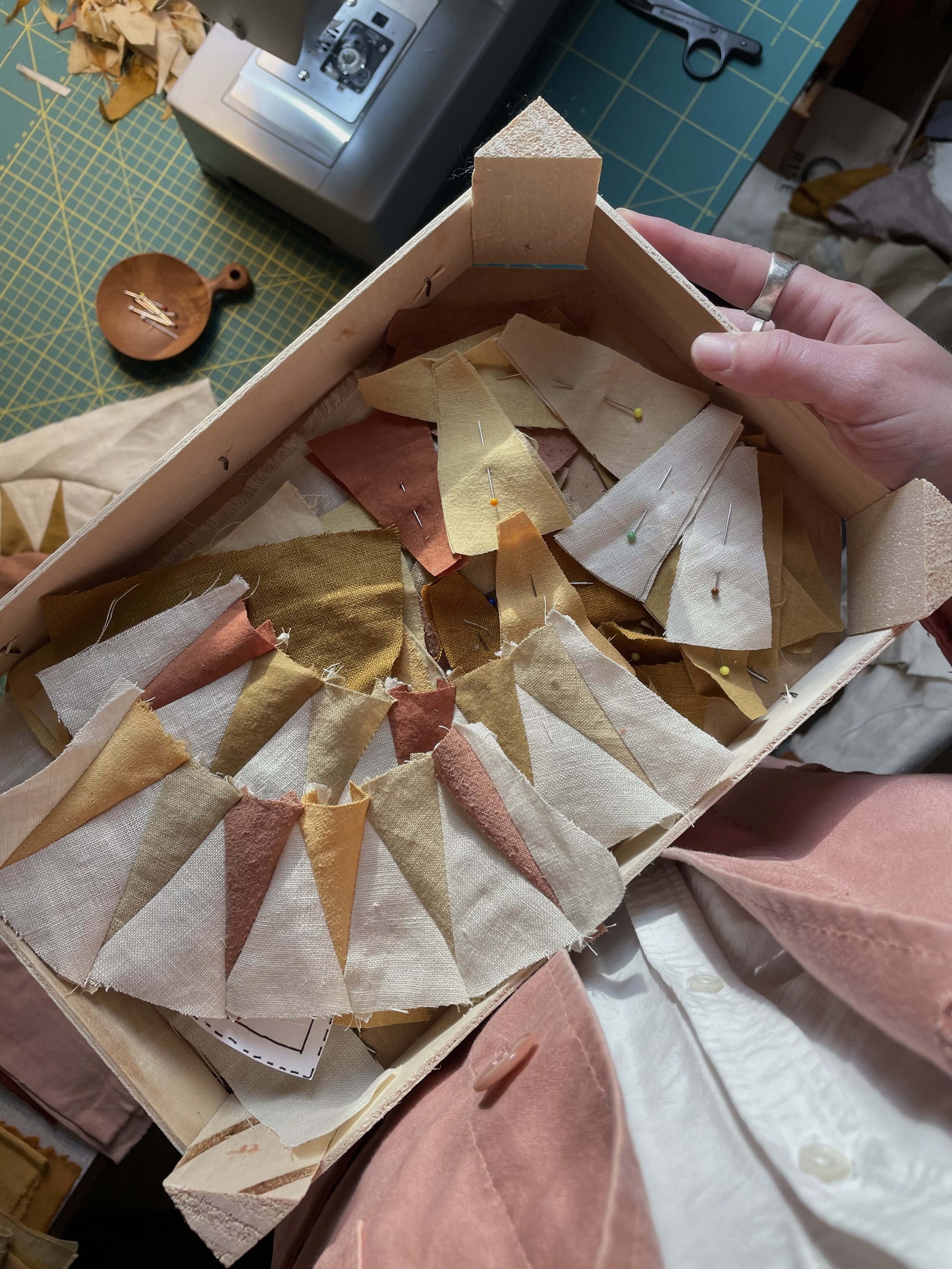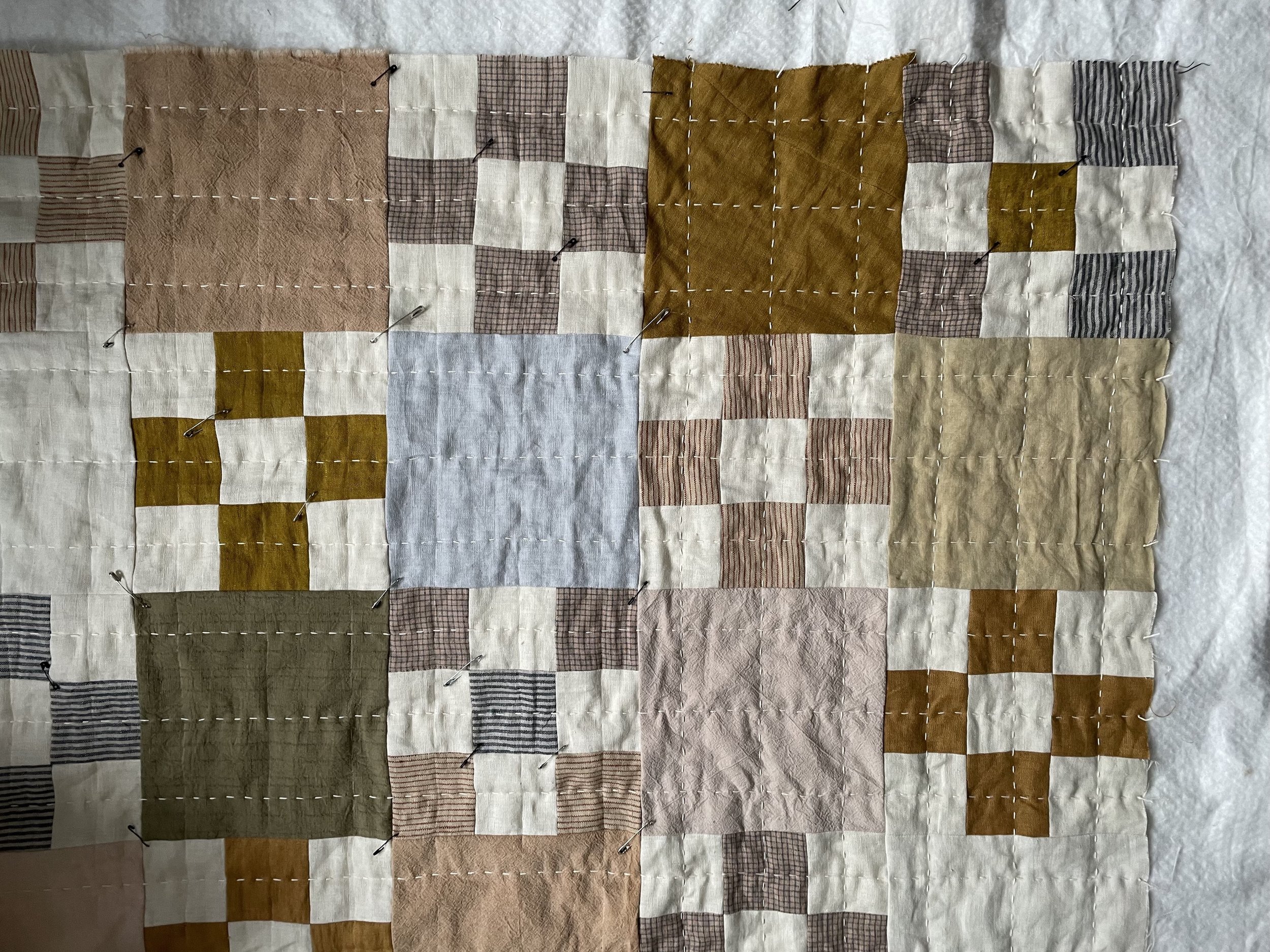
Quilts are community care, especially when they raise mutual aid & awareness. Throughout time, quilters have been notably political and skilled at using their art for change.
So you want to run a quilt fundraiser…now what?
I have organised two PLQ quilt fundraisers raising respectively £19,000 and £6,000 for organisations doing work I am passionate about supporting.
I am not a seasoned fundraising expert! But I receive emails from fellow quilters asking for advice. I first learned how to run a quilt fundraiser from quilters Grace Rother and Elizabeth McMurtry, who answered my emails. Since stating PLQ, I try to run one quilt fundraiser each year to re-distribute resources and raise awareness.
On this page you will find some notes on what has worked for me and my collaborators. I hope my thoughts here are useful. Get out and raise funds and awareness with your quilts, carrying forward the wonderful history of politically active quilters.
We quilters have always cared for community.
(photo: banner artist Alice Gabb & PLQ for the GAY OKAY fundraiser, 2022)
community quilts
community quilts
Decolonise The Garden & Public Library Quilts collaborated with Land in Our Names to sew a community sourced quilt for land & racial justice raising 19,000 GBP
Fundraising as a Quilter
Choosing a Cause
What is a cause that you not only feel passionate about but also feel comfortable educating folks about?
When I run a fundraiser, I ask myself ‘will I be asking any labour of the marginalised people or community I am raising funds for?’ My goal is to never make more work for any of the communities I want to help direct resources towards. What do I need to do to educate myself? How can I team up with folks with lived experience of the issues at stake? Is there a charity or mutual aid group that does want to team up and do work together or is there an informed way in which I can simply get money to a great cause?
You might be raising for a cause you have intimate lived experience of. However if you are not, I find this example of ‘how to come correct’ from an Indigenous rights & land rematriation group really helpful. This is a set of questions that you can ask yourself when you are preparing to approach a community you want to raise funds for. More here: sogoreate-landtrust.org/slt_resources/how-to-come-correct/
Bottom line: never make more work for marginalised communities.
It is also really important to make it easy and conflict free for someone to tell you ‘no.’ The fundraiser you want to run might just not work for a group right now or carry timing issues, complexities, or labour you can’t intuit. If you are not part of the living community you are raising funds for and/or part of the specific charity or mutual aid group then you are a guest in their space, their authority, and their work.
Ask genuinely how you can help and accept that no means no.
Charity Vs. Mutual Aid?
Do you want to raise for a registered charity or a mutual aid group?
If you are raising for a charity: do you know how much of their fundraising actually ends up in the community they are helping? Do you know if their leadership is comprised of people from the community they are helping? Is this charity doing structurally impactful work or is it just re-performing the structures that have marginalised a group in the past?
Sometimes it is simply easier for folks to donate to a registered charity. Depending on your audience and international reach, you may want to choose a charity that can readily process online donations.
If you are raising for a mutual aid group: are you prepared to educate your audience about what mutual aid means? Mutual aid works from the principle that we should get resources to the people with the most lived experience of the problem at hand. I think it is a wonderful and powerful thing that helps us redistribute resources and actualise grassroots change.
If you are raising for a small/hyper local cause, you might need to check how they are set up to take in donations and if this process will be easy for your audience. Depending on the online presence of the mutual aid group, you might want to set up a fundraising donation page where money does pass through you.
If you are trying to explain a mutual aid group to your audience in a fundraiser it can be helpful to be really concrete about what the money raised will make possible. This is especially true if the group doesn’t have an established online presence people can explore.
Collaboration
I love collaborating on a fundraiser: it makes me and the work better in so many ways and it shares the labour.
My advice on finding a collaborator is two-fold:
Work with someone with different lived experience than you and/or different skillsets than you.
Work with someone who respects boundaries. Fundraisers are a lot of work and not all of the labour is immediately obvious from the outside. Talk about what you can each give to this and what your expectations are of each other.
Tell a Story
People connect to stories. Narratives are powerful: what will this fundraiser make possible? I think a good fundraiser story connects the big picture with the micro impacts. It helps us think about a huge abstract issue (climate crisis, trans rights, Land Back etc.) in really concrete actions that matter to people living the structural problem.
Tell people what gives you hope about this issue, this story and how they can be apart of it.
Money Money Money
There are many ways to raise funds. Remember to check the laws around gambling (often raffles fall under this) for where you live: you might be ok taking a risk, but you don’t want to endanger any small charity or marginalised mutual aid group you are working with.
I personally like it when people make direct donations to the cause. I keep track of this by simply checking with the organisation that the draw winner was indeed truthful about their donation.
I also like to make sure that everyone, regardless of financial privilege, has the same chance to win the quilt. I set a suggested minimum donation and encourage people to give in relationship to their finances. One person = one entry for the quilt. This has worked very well for my fundraisers with donations ranging from £10 to £200.
Practical Stuff + Photography
The most important thing for a quilt fundraiser is good photography of the quilt that helps people imagine it in their lives and see its beauty. Ask around if a professional photographer might donate their time to your cause. If not, photograph in natural light. Try to take a few different kinds of photos for varied content. Consider borrowing a friend’s bedroom or front pouch, taking the quilt to a nature area, or local community space to display the quilt and tell people about it in person while you get some photos.
Create a clear infographic using free tools like Canva so that everyone involved in the fundraiser can share the same guidelines for entry. People need frictionless ways to easily understand and donate otherwise it will fall to the bottom of their to do list.
Remember to ask permission from the organisation you are raising for before using their photos, graphics, or logo. Put these materials into a shared folder and have everyone involved post at different times throughout the fundraiser to keep a steady flow of content.
community quilts
community quilts
Eight embroiders filled a signature quilt with the names of Black women authors for Kin Folk Archive’s story circles. An additional fundraiser quilt made with scraps raised a seed grant for Ashley J. May’s work.
Kinds of Fundraiser Quilts
you make the quilt
Maybe you have a quilt looking for a home. Maybe you have fabric that is begging to be made into a quilt. The most straightforward way quilters have raised money in the past is simply by doing what they do best: making a quilt. You might consider if you want to ask your community for fabric donations or share the financial cost of making a quilt and ask for initial donations depending on what financial resources you have available to you for this work.
community quilts
A wonderful version of a traditional quilt fundraiser involves different quilters making blocks of the same size to contribute to a community quilt. There are many advantages to this: many quilters work is celebrated and uplifted, everyone becomes deeply invested in the work, & more individuals are educating their communities about the community quilt during the fundraiser period. The block method also distributes cost and labour hours.
signature quilts
One of the oldest styles of quilt fundraisers involves asking folks to essentially ‘buy a block’ or pay to have their name or the name of their businesses added to the surface of the quilt. I can see wonderful ways to make this a contemporary tradition that maybe involve auctioning off or creating a ‘sponsor a quilt block’ phase in your fundraiser to get community involved as the quilt is made.
The Gay Okay Quilt & Banner fundraiser
In Spring 2022, activist and banner artist Alice Gabb and PLQ teamed up with Common Threads Press and One Tiny Bookshop to raise money for two LGBTQAI+ orgs in the United States.
With anti-queer & trans laws on the rise in the US, places of sanctuary and identity affirmation are more important than ever for youth. Our quilt, banner, and books raised £6,000 for Gender Nation which helps get affirming books into public school libraries and True Colors United which provides access to safe youth housing.
Our quilt was made with plant dyed fabric made by social initiative Sew & Grow, helping at risk young people through alternative educational opportunities in their dye garden, farm, and studio.




